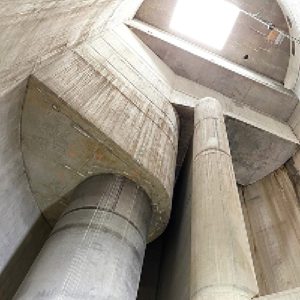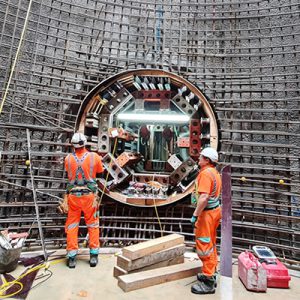River Thames, London, UK
Tideway’s plans to upgrade London’s sewer system, cleaning up the River Thames and increasing the capital’s sewer capacity, have seen leading formwork, falsework, and ground shoring provider, RMD Kwikform (RMDK), play a vital role in supporting the construction of the project’s King George’s Park and Dormay Street shafts.
The Thames Tideway Tunnel is being developed in response to London’s rapidly growing population. London’s Victorian sewers were designed to serve 4 million people, but with nearly 9 million people using the sewer network today and the city’s population estimated to increase to 16 million by 2160, Tideway is constructing a 25km long ‘super sewer’ to intercept, store and ultimately transfer sewage waste away from the River Thames.
With even light rainfall currently causing untreated sewage to spill into the River Thames, the new tunnel will tackle these problems and protect the river for at least the next 100 years.
 RMDK has supported on a range of sites along the 25km main tunnel, including constructing the shafts at King George’s Park and Dormay Street. Work at Dormay Street involves connecting the existing local combined sewer overflow (CSO) to the main tunnel, and the site is also being used to drive a long connection tunnel southwards to King George’s Park and northwards to Carnwath Road Riverside, known as the Frogmore Connection Tunnel.
RMDK has supported on a range of sites along the 25km main tunnel, including constructing the shafts at King George’s Park and Dormay Street. Work at Dormay Street involves connecting the existing local combined sewer overflow (CSO) to the main tunnel, and the site is also being used to drive a long connection tunnel southwards to King George’s Park and northwards to Carnwath Road Riverside, known as the Frogmore Connection Tunnel.
The King George’s Park site is the start of the Frogmore Connection Tunnel, which will link sewer overflows into the main tunnel. Construction in the west region is being delivered by a joint venture of BAM Nuttall Ltd, Morgan Sindall Plc and Balfour Beatty Group Limited (BMB).
Because both shafts intersect with the main tunnel, one of the key challenges with this project was to ensure all the structures within these shafts could be built simultaneously, to help ensure the next construction phase on the main tunnel didn’t fall behind schedule. As such, the systems provided needed to be quick to assemble, dismantle and manoeuvre, simple to use, and adaptable, so that as construction work progressed up these shafts, the systems could accommodate all the different construction processes underway at each level.
 RMDK supplied temporary works solutions for forming concrete elements on all aspects of the shafts, with both shafts’ linings achieved through slipform construction. Formwork was supplied for the surface and internal shaft structures, and these incorporated the temporary works structures needed to withstand demolition and breaking during the works.
RMDK supplied temporary works solutions for forming concrete elements on all aspects of the shafts, with both shafts’ linings achieved through slipform construction. Formwork was supplied for the surface and internal shaft structures, and these incorporated the temporary works structures needed to withstand demolition and breaking during the works.
RMDK supported the delivery of the project with 3D modelling, due to the complex geometry of some of the structures. With over 40 tonnes of equipment on site at any one time, this helped BMB minimise risks, while streamlining workflows and enabling greater collaboration across the supply chain. For instance, the sharing of 3D models enabled early intervention to prevent materials from clashing in the interface between the permanent and temporary works.
Throughout the construction process, weekly meetings were held between the RMDK and BMB teams, so designs could be modified and updated as these works progressed. BMB has highlighted the fact that access to a dedicated senior engineer, capable of supplying both 2D and 3D drawings, was instrumental to the successful completion of both sites’ shafts, reducing design time and ensuring the construction programme for both sites always remained on track.
Temporary works solutions for forming concrete elements on all aspects of the tunnel shafts
To ensure all the structures within these shafts could be built simultaneously, to help ensure the next construction phase on the main tunnel didn’t fall behind schedule
Formwork was supplied for the surface and internal shaft structures, along withe 3D modelling
To satisfy the demands of these projects, RMDK provided a range of temporary works systems, which included its Alshor, Rapidshor and Megashor falsework solutions, Superslim Soldier primary formwork beams, aluminium beams, heavy-duty Maxima wall formwork panels, and Trapeze panels for curved wall formwork.
Another project challenge was ensuring all processes – whether it be construction, demolition, plant use, and so on – could be undertaken from the same deck, without this having to be changed. The high strength, light weight, and flexibility of a shoring system such as Alshor meant this was ideally suited to meet these needs. Russell Stanley, Project Manager for Tideway at RMDK, added:
Close collaboration throughout both projects ensured programmes remained on schedule, workflows between all parties were streamlined, and any issues could be quickly identified, before they had the chance to become a bigger problem.